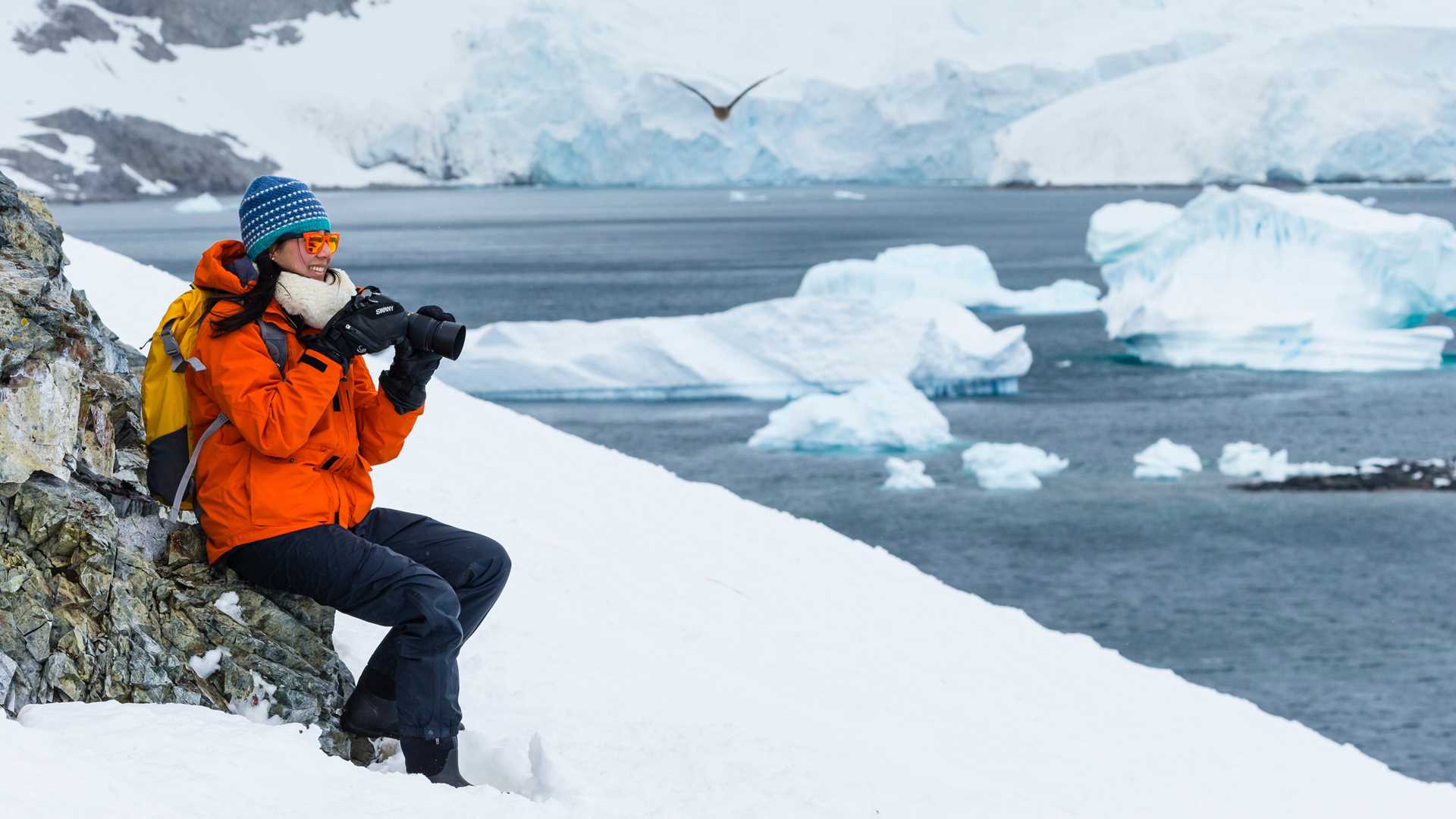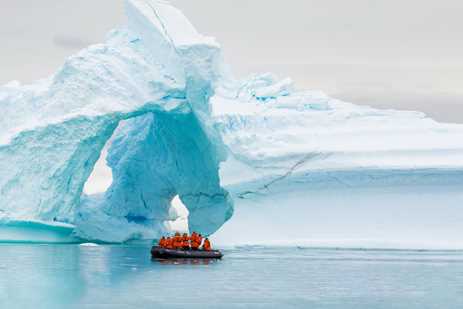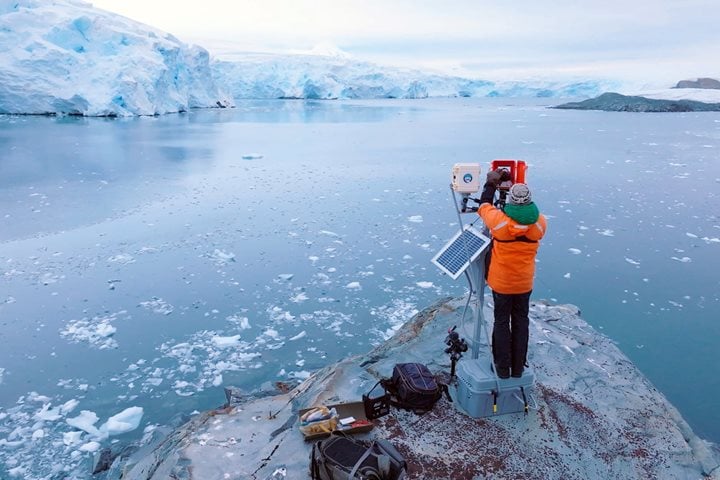Call +1.800.397.3348 or contact your travel advisor
Though it’s one of the coldest, windiest, wildest environments on Earth, packing for a cruise to Antarctica doesn’t have to be intimidating. When you consult a trustworthy guide, the process becomes much more manageable, and you can get back to focusing on the fun part—anticipating your once-in-a-lifetime adventure!
Lindblad Expeditions, the pioneers of Antarctic exploration, has been bringing citizen explorers to this legendary land for more than 55 years and, in that time, have developed a deep well of expertise.
Below, you’ll find a recommended packing list, followed by more detailed breakdowns and answers to some common questions for those who want to do their own research. Whichever route you choose, you’ll be prepared for anything the White Continent decides to dazzle you with.
Antarctica Expedition Packing List
- Parka or jacket: Hooded, insulated, and water-repellent
- Waterproof rain jacket: For rainy or windy weather in Ushuaia, Argentina
- Wool ski cap: Add a scarf if the cap cannot be pulled down to cover your neck
- A pair of waterproof pants: Loose enough to wear over a regular pair of trousers
- Ski mittens or gloves: One or two pairs of waterproof options
- Polypropylene glove liners: To layer under your ski mittens
- Knee-high rubber boots: Fully waterproof with sturdy, high-traction soles
- Walking shoes: Comfortable shoes with rubber soles for use aboard the ship
- Wool socks: Three or four pairs that are warm, sturdy, and tall
- Thin socks: Three or four pairs to wear under tall socks for extra insulation
- An assortment of fleeces, sweaters, and other layered clothing
- One full set of thermal or silk long underwear
- One or two bathing suits: For the onboard saunas or hot tubs or an invigorating polar plunge
- Workout clothing: For use in the ship’s fitness center
- Water-resistant backpack: For carrying cameras or other equipment
- Sturdy sunglasses: One or two pairs with UV protection
- Binoculars
- Personal toiletries: Including sun block, moisturizing lotion, and lip balm
- Electrical converter and adapter: For your hotel stay in South America (220V to 110V)
- Camera and gear: Lenses, extra memory cards/film, battery charger, extra batteries
Note: On voyages with National Geographic-Lindblad Expeditions, a complimentary parka or jacket is provided to guests.
What Should I Pack for Antarctica?
The cold weather is without a doubt the biggest factor to consider when thinking about your packing checklist. Your cruise to Antarctica will take place during the austral summer—from November through early March—when temperatures hover around freezing but can reach lows of 20 degrees Fahrenheit before even adding in the wind chill.
Luggage is subject to strict per-passenger weight limits on flights to and from Ushuaia, so guests traveling to Antarctica should consider packing light. It’s not uncommon to re-wear expedition clothes, especially your mid-layers, but keep in mind many ships offer laundry service for an additional fee.
Gear rental is also a great (and sustainably minded) solution for those who aren’t likely to reuse their Antarctica gear at home or on future travels. Check with your expedition cruise operator to see if they recommend a particular rental company.
What Should I Wear in Antarctica While on Excursions?
In the polar wilderness, your clothing choices are a matter of safety just as much as comfort. While it may be tempting to pack a pile of your coziest, heavy-weight sweaters, bulky items are simply not ideal Antarctica clothing. Instead, multiple light- and medium-weight layers are a more effective strategy when it comes to mobility, adaptability, and keeping warm on your excursions.
A layering system that combines a base, insulation, and outer layers is a trusted method for polar explorers. Warm air gets trapped between each layer of clothing, insulating much more effectively than a single, thick layer would.
Also note that with nearly 24 hours of daylight, the sun can feel surprisingly hot when you’re sheltered from the fierce winds or as you exert energy on an afternoon hike. Dressing in layers allows you to adjust your comfort level by removing or replacing items as needed.
Base Layers
Thin, breathable base layers are a necessary foundation and should fit snugly against the skin. Moisture-wicking synthetic fabrics like nylon and polyester are best for regulating your body temperature—they keep you warm when you’re resting and cool when you’re hiking at the bottom of the world.
Merino wool is a great natural alternative for a moisture-wicking base layer. Wool absorbs a small amount of liquid into the core of its fibers, while also wicking moisture out through small, porous openings within the fabric. That keeps the surface of the yarn dry to the touch and in turn keeps you comfortable.
Underwear
Bring underwear and sports bras that are supportive and comfortable. Some brands that lead the pack on technical travel underwear include Icebreaker, Outdoor Research, and ExOfficio.
Long Underwear Tops
Mid-weight thermals will be the heroes of your layering system. Patagonia has excellent options like the Capilene® Midweight Crew, which is made of a super-soft Polartec fabric with plenty of stretch.
Long Underwear Bottoms
Good long underwear should stay put when you move, so spend some time making sure you have the right fit and a comfortable waistband. Flatlock seams will also help to avoid chafing.
_______________
Insulation Layers
These are the items that you will don over your base layers. Go for a synthetic blend or fleece that’s loosely sized to fit on top of your thermal underwear. Anti-microbial fabrics will stay fresh through multiple days of adventure.
Long-Sleeve Top
Pack one or two light pullovers, hoodies, or zip-ups of medium weight. Patagonia’s R1® pullover is a great minimalist pick and their Nano Puff® down alternative jackets block wind and traps body heat.
Fleece Pants / Leggings
When conditions are especially cold, wet, or windy, a fleece bottom layer is a must. To ensure a comfortable fit inside your boots, they should have a tapered leg.
Tall Merino Wool Socks
Pack three or four pairs in different weights, and an equal number of thinner socks or liners in silk or polypropylene to layer underneath for warmth or to create a better boot fit. Darn Tough’s cushioned performance socks are a favorite of many seasoned hikers and adventure travelers.
Outer Layers
On most—if not all—shore excursions, Zodiacs make wet landings into icy water, and wet skin puts you at risk of frostbite. Take a cue from the penguins and ensure your outermost layers are 100 percent waterproof, not just water-resistant. Bring doubles of anything that might get wet, like mittens and socks.
Waterproof Pants
These should be made of Gore-Tex or a similar waterproof, breathable fabric and need to fit over all of your layers and knee-high boots. Make sure you try them on with everything you’ll be wearing to ensure you choose the right size. Ski pants are an option; however, some find them too bulky to sit in while kayaking or to hike in for longer periods.
Tall Muck Boots
100 percent waterproof, rubber muck boots are designed to deliver grip and performance on snow, ice, and rough terrain while keeping your feet warm and dry. Comfort is key—if your boots are too heavy or bulky, your footing will be awkward during hikes.
Wellington boots, XtraTufs, or “muck” boots like ones from Bogs or Honeywell can be purchased at sporting goods stores, fishing supply stores, and from outdoor clothing suppliers.
If you’re traveling with National Geographic-Lindblad Expeditions, you can also rent your boots through Ship to Shore Traveler and you’ll find them waiting in your cabin when you arrive aboard ship.
Gloves
Pack one or two pairs of waterproof ski gloves or mittens. If your fingers are especially prone to freezing, mittens will have more room for hand warmers. You might also opt to wear thin, windproof liners underneath so you can remove your gloves to photograph Antarctica’s legendary light without your fingers getting cold.
Neck Gaiter or Buff
These secure alternatives to fussy wraparound scarves will keep your neck covered and can easily be pulled up over your nose and mouth during icy wind chills—or to filter out some of the “eau de penguin colony.”
Warm Hat or Beanie
The most important factor for a good Antarctica hat is a secure fit; otherwise, the wind might take it from you. Some options come with a visor to shade your eyes and flaps to protect your ears. Balaclavas are also a good option.
Rain Jacket
To be prepared for any inclement weather in Ushuaia during your travel to Antarctica, it’s best to wear a lightweight shell that’s windproof and waterproof.
Clothing for Around the Ship
Leave the high-fashion aprés-ski clothes at home. In fact, your onboard polar expedition attire doesn’t need to be all that different from what you wear ashore.
Indoor environments will be nice and cozy, of course, but keep your windbreaker or parka handy so you’re prepared to quickly head out on deck when the captain announces a whale or iceberg sighting.
Casual Tops / T-Shirts
Bring a few lightweight tops, so you can layer and rewear them. A mixture of tank tops, short-sleeve, and long-sleeve options.
Casual Pants
The wool or fleece pants you wear in between your long underwear and rain pants will also work well for hanging out on the ship. You also can’t go wrong with a pair of jeans, leggings, joggers, khakis, or other casual pants.
Comfortable Closed-Toe Shoes
Conditions on deck might get slippery, so sturdy shoes with rubber soles like sneakers, low-top hiking shoes, or duck boots are highly recommended. Some common brands include Merrell, Salomon, and Danner.
Light Fleece Jacket
Fleece is lighter and dries more quickly than wool. This coat option can also serve as a mid-layer on colder excursion days.
Workout Clothing
Bring one or two sets of your favorite fitness clothes for sessions at the gym or wellness classes offered on board.
Bathing Suit
Even if you’re unsure about partaking in a “polar plunge,” you’ll regret not having a bathing suit if your ship offers a sauna or hot tub to relax in after coming in from a chilly Zodiac ride.
Clothing: FAQs
Still have questions about what to wear on an Antarctica cruise? Here are answers to some common questions you might be wondering about.
What Sort of Footwear Do You Need for the Boat?
Aboard the ship, you will need comfortable, closed-toe walking shoes with rubber soles. It’s not at all required, but some folks do find slip-on shoes nice so you don’t have to worry about laces when changing in and out of your excursion gear.
Is It Worth Taking Walking Boots?
You won’t need them for excursions in Antarctica, but if you plan to add on an extension voyage, there is excellent hiking in Ushuaia and neighboring areas of Patagonia. If you do bring walking boots, they can double as your ship shoes to save space.
What Types of Boots Do I Need to Bring?
A pair of fully waterproof knee-high rubber boots with sturdy, high-traction soles is essential. Muck boots are specifically designed to stand up to slick ice and uneven terrain.
Are Muck Boots Included or Do I Need to Bring or Rent Them?
This varies by cruise company. When boots are not included, renting is a convenient option, and it will ensure you don’t track any invasive species from home into the delicate Antarctic ecosystem.
Where Would You Recommend Buying Polar Clothing?
Reputable technical clothing brands include Patagonia, Arc'teryx, Icebreaker, and Smartwool. Many of these can be found at outdoor stores like REI, Backcountry, or Paragon Sports.
If you don’t plan on using this type of gear after you voyage, renting is a more sustainable alternative. National Geographic-Lindblad Expeditions partners with Ship to Shore Traveler to offer curated Antarctica gear collections for both adults and children.
What Is the Typical Dress Code on Board the Ship?
While some of the larger luxury ships may require more formal dress for dinner, the atmosphere aboard smaller expedition cruises is generally much more casual. Many passengers wear outdoor or athleisure attire and, again, layering up is always smart.
Will I Need to Bring a Winter Jacket If a Parka is Provided?
The complimentary high-performance parka provided by National Geographic-Lindblad Expeditions combines maximum polar functionality and comfort. It should be more than enough to keep you warm and dry. If you tend to get cold quickly you might also bring an ultra-lightweight, down jacket—which is easy to pack down into your luggage or daypack—as an extra layer under the parka.
Other Items to Pack for Antarctica
When considering what to pack for an Antarctica cruise, it’s important to note that the midnight sun shines for nearly 24 hours each day—and its brightness is even further amplified by the glistening white snow and ice. That means UV protection is absolutely paramount.
Before you plan to pack anything that’s not on the following list—a reusable water bottle, for example—check with your tour operator to be sure it’s not included as part of your overall cruise cost.
Passport
- It's essential to have your passport and pre-travel documents in order before traveling.
Sunscreen (SPF 15 or higher)
Sunglasses
Croakies
Extra Pair of Prescription Glasses
Binoculars
Seasickness Medication
-
Try over-the-counter meds like Bonine and Dramamine or Scopolamine which requires a prescription.
Toiletries
Eye Mask
Lip Balm
Hot Hands Hand Warmers
Dry Bag or Dry Bag Backpack
- A dry bag or dry bag backpack will protect your gear when kayaking or hiking in the icy Antarctic wilds.
Apple Air Tags
Camera Gear and Lenses
- On a photography expedition to Antarctica, it's critical that you don't forget your camera and lenses.
Camera Batteries and Charger
Extra SD Cards or External Hard Drive
Power Brick
Tech Device Chargers and Cords
Journal and Pen
What Should You Not Pack for Antarctica?
Invasive species are at the very top of the do-not-bring list. Antarctica’s pristine landscapes are especially vulnerable to non-native organic material. Be sure to diligently clean clothing and footwear before packing it— paying special attention to any Velcro—to remove seeds, mud, grass, leaves, or any other plant parts.
You should also steer clear of packing cotton clothing; it just doesn’t stand up to the insulation abilities of synthetic fabrics or wool. Even as a base layer, cotton fabrics don’t wick moisture like their wool and polyester alternatives.
Additionally, double check whether your cabin stocks personal care basics like shampoo, conditioner, soap, and lotion before packing them.
Is It Worth Taking Trekking Poles?
A helpful tool for navigating uneven or slippery terrain, hiking poles help ensure safety and stability out on the frozen tundra. When you travel with Lindblad Expeditions–National Geographic, for example, wooden hiking poles are available for complimentary use. If you prefer to have your own, choose a collapsible set so that they can fit into your day pack.
What Kind of Luggage Should I Use?
Check with your travel outfitter to determine what storage options will be available in your cabin. On some ships, you might be able to fit a hard-shell suitcase under your bed. But soft-sided luggage is likely the better choice since it will be easier to stow, plus, these bags tend to offer more give; Remember: you’ll need to save some space to bring your new parka back home!
Many avid travelers recommend Patagonia’s 70L Black Hole Wheeled Duffel. It’s built to last with highly weather-resistant fabric. In addition to the roomy main compartment, it has an external zippered side pocket and mesh pockets in the lid to keep smaller items organized. The larger 100L Black Hole duffel is also an option if you’re careful not to fill it with more than the airline’s weight limit.
The North Face’s lightweight but rugged Base Camp Duffel is a similarly dependable pick. The 71L Medium is sized to fit in overhead airline compartments and has a large exterior pocket for items you want to have easy access to like your wallet or notebook. If you’d prefer to go hands-free, opt for the 65L Osprey Transporter, which boasts comfortable padded straps and an adjustable sternum strap modeled after the brand’s popular backpacking packs.
For your Antarctica packing list to be fully comprehensive, there’s one more thing you need to bring along: a sense of adventure! Even equipped with a perfectly packed bag, you are still heading to one of the world’s most uniquely unpredictable regions. Trust in your expert expedition team and the willingness to step beyond your everyday comfort zone will pay off just as much as any gear will.










